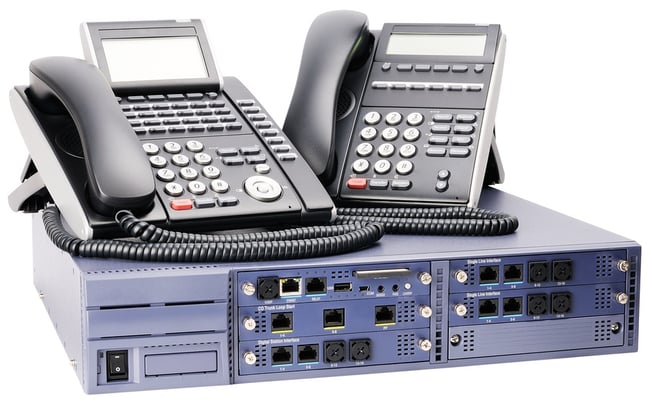What is a Hosted PBX system?
The acronym PBX stands for Private Branch Exchange, where a complete system is housed in a building or an office. Desktop phones and external telephone lines are both connected to the telephone system which acts as a ‘switch’ routing calls either internally to staff or externally to the public network. Traditional Time Division Multiplexers (TDM) PBX’s, consists of lots of hardware and components, require separate cabling, telephone ports for each phone and require specialist engineers to install and configure the system. More modern IP PBX systems are server based that connect on the network and utilises existing network and cabling infrastructure to connect IP Phones. Hosted or cloud based phones mean that the system is not installed at the businesses premises rather offsite in a data centre, which could be anywhere in the world. All a business requires on site is a POE switch and IP phones that connect to the system over the internet, broadband or Ethernet circuit. A business may decide to host their IP PBX system in a data centre or choose to purchase the use of a system’s resources from a cloud based provider.There are pros and cons for each type of approach. Generally, speaking a business has more control and flexibility over owning their own system, however, incurs the associated costs of managing and maintaining it. A cloud based solution, however, tends require less management as the only element that the businesses is responsible for is the POE switch and the IP handsets.
How do Cloud Based Telephony Systems Work?
With a cloud based solution all the sophisticated routing of calls is all handled by the service provider. All the business needs to do is connect IP Handsets to their office network and allow for a fibre connection (SIP Trunks) to be installed so calls can be directed in and out of the office. Each phone user will have their own telephone number and log in number so they can log into any IP phone to receive their calls. The initial configuration of the solution is generally done by the provider, however, once this has been setup the business can also have some control via web based portal to allow them access to make configuration changes as they see fit.
The Benefits of Cloud Based Phones
Cloud and system based IP PBX solutions are fairly similar in functionality depending on which service provider or brand of IP PBX a business opts for. The significant difference between the two solutions is the payment model. A system based solution means purchasing the system upfront, which can result in significant upfront costs. However, once the system is in place the business can use the system for a number of years without further serious investment besides upgrades and annual maintenance charges.
A cloud based solution doesn’t require a significant investment upfront, instead there are ongoing monthly charges based on the number of users. These charges will always remain in place for as long as the solution is being used. However, on a good note there are no system upgrades or ongoing maintenance charges as keeping the system up to date is the responsibility of the service provider.
Is a Hosted PBX System Right for My Business?
It is difficult to generalise what is best for any businesses without having any insight of a business’ telephone needs or requirements. If a business currently has TDM PBX it would be advisable to investigate both cloud and IP system solutions to determine which would deliver the best benefits or is more suitable to the business.
Generally speaking, system based IP solutions will always be capable of delivering more features and have more functionality simple because proprietary protocols (between handset and system) deliver more features. Furthermore, there is more control as you own the system outright.
Cloud based solutions use an industry standard protocol SIP (Session Initiated Protocol). Essentially, SIP is the common language enabling interoperability between different manufactures – in this case – the cloud based system and SIP Phone. Though SIP delivers plenty of features and it is possible to divert and pick up calls, it might be harder or more complex to do on a SIP phone. Therefore, it is worth checking the basic features to ensure they are what the business or team are currently used to.
With cloud based solutions it is possible to add or remove specific functionality including user licences as and when required. Therefore, this could be useful for a business that has seasonal peaks and require additional staff for a month or two.
Points to Note When Considering Cloud Based Telephony
For some businesses, it can be a straight forward decision to opt for cloud based solution as they simply don’t want the hassle of managing an on-site system or pay for it outright. However, if you don’t fall into this category we would suggest that you engage with a telecoms provider that offers both solutions and can advise you which would be the best solution for your business based on your needs and requirements.






